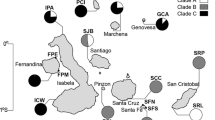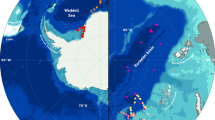Abstract
Holothuria arguinensis, Holothuria mammata and Holothuria forskali are three common sea cucumber species found in the NE Atlantic, traded in international markets and susceptible to capture. Allometric relationships reveal if the scaling relationships between biometric characters are proportional with growth, being a useful tool to understand species growth strategies. Allometric relationships of the three species were estimated and compared between them and with populations from different regions. These allometric relationships revealed that the three species have negative allometric growth. However, they have different growth strategies between them and reveal different regional intra-specific growth strategies when compared to other populations, suggesting ontogenetic adaptation as a consequence of external factors.



Similar content being viewed by others
Data availability
The datasets generated during and/or analysed during the current study are available from the corresponding author on reasonable request.
References
Ahmed Q, Poot-Salazar A, Mohammad Ali Q, Bat L (2018) Seasonal variation in the length-weight relationships and condition factor of four commercially important sea cucumbers species from Karachi coast- Northern Arabian Sea. Nat Eng Sci 3(3):265–281
Alberts JR, Harshaw C (2014) Behavioral development and ontogenetic adaptation. In: Yasukawa K, Tang-Martinez Z (eds) Animal behavior: How and why animals do the things they do. 1, 289–324
Aydın M (2020) Length-weight relationships and condition factor of four different sea cucumber species in the Aegean Sea. J Anatolian Environ AnimSci 5(1):80–85
Bradshaw CJA, McMahon CR (2008). Fecundity. In: Jørgensen SE, Fath BD (eds) Encyclopedia of ecology. Academic Press, Oxford, pp 1535–1543. https://www.sciencedirect.com/science/article/pii/B9780080454054006455
Conand C (1981) Sexual cycle of three commercially important holothurian species (Echinodermata) from the lagoon of New Caledonia. Bull Mar Sci 31(3):523–543
Conand C (1993) Reproductive biology of the holothurians from the major communities of the New Caledonian Lagoon. Mar Biol 116:439–450
Dereli H, Çulha ST, Çulha M, Özalp BH, Tekinay AA (2016) Reproduction and population structure of the sea cucumber Holothuria tubulosa in the Dardanelles Strait, Turkey. Mediterr Mar Sci 17(1):47
Eriksson H, Clarke S (2015) Chinese market responses to overexploitation of sharks and sea cucumbers. Biol Conserv 184:163–173
Flammang P (1996) Adhesion in echinoderms. Pp. 1–60 in Echinoderm Studies, Vol. 5, M. Jangoux and J. M. Lawrence, eds. Balkema, Rotterdam
Froese R (2006) Cube law, condition factor and weight–length relationships: history, meta-analysis and recommendations. J Appl Ichthyol 22(4):241–253
Gonçalves EJ, Henriques M, Almada VC (2002) Use of a temperate reef-fish community to identify priorities in the establishment of a marine protected area. In: Beumer JP, Grant A, Smith DC (eds) Aquatic protected areas: What works best and how do we know? Proceedings of the World Congress Aquatic Protected Areas, Cairns, Australia: Australian Society for Fish Biology: 261–272
González-Wangüemert M, Aydin M, Conand C (2014) Assessment of sea cucumber populations from the Aegean Sea (Turkey): first insights to sustainable management of new fisheries. Ocean Coast Manag 92:87–94
González-Wangüemert M, Dominguez-Godino JA, Canovas F (2018) The fast development of sea cucumber fisheries in the Mediterranean and NE Atlantic waters: from a new marine resource to its over-exploitation. Ocean Coast Manag 151:165–177
Gould SJ (1966) Allometry and size in ontogeny and phylogeny. Biol Rev 41(4):587–638
Hallgrimsson B, Percival CJ, Green R, Young NM, Mio W, Marcucio R (2015) Chapter twenty - morphometrics, 3D imaging, and craniofacial development. In: Yang BT (ed) Craniofacial development, current topics in developmental biology chai. Academic Press, pp 561–597
Hamel JF, Mercier A (2009) Endogenous and exogenous control of gametogenesis and spawning in echinoderms. Academic Press
Henriques M, Gonçalves EJ, Almada VC (1999) The conservation of littoral fish communities: a case study at Arrábida coast (Portugal). In: Almada VC, Oliveira RF, Gonçalves EJ (eds) Behaviour and conservation of littoral fishes Lisboa: Instituto Superior de Psicologia Aplicada, pp 473–519
Herrero-Pérezrul MD, Reyes-Bonilla H (2008) Weight-Length relationship and relative condition of the holothurian Isostichopus fuscus at Espíritu Santo Island, Gulf of California. México Revista de Biología Tropical 56(3):273–280
Hossain MY (2010) Morphometric relationships of length-weight and length-length of Four cyprinid small indigenous fish species from the Padma River (NW Bangladesh). Turkish J Fish Aqua Sci 10(1):131–134
Jacob J, Gama C, Salgado R, Liu JT, Silva A (2009) Shadowing effects on beach morphodynamics during storm events on Tróia-Sines embayed coast, southwest Portugal. J Coast Res 73–77
Jesús-Navarrete AD, Poot MNM, Medina-Quej A (2018) Density and population parameters of sea cucumber Isostichopus badionotus (Echinodermata: Stichopodidae) at Sisal, Yucatan. Lat Am J Aquat Res 46(2):416–423
Kazanidis G, Antoniadou C, Lolas AP, Neofitou N, Vafidis D, Chintiroglou C, Neofitou C (2010) Population dynamics and reproduction of Holothuria tubulosa (Holothuroidea: Echinodermata) in the Aegean Sea. J Mar Biol Assoc UK 90(5):895–901
Keys AB (1928) The weight-length relationship in fishes. Proceedings of the National Academy of Science, Vol. XIV, no. 12, Washing-ton, DC, 922–925
Le Cren ED (1951) The Length-weight relationship and seasonal cycle in gonad weight and condition in the perch (Perca fluviatilis). J Anim Ecol 20(2):201
MacDonald CLE, Stead SM, Slater MJ (2013) Consumption and remediation of European Seabass (Dicentrarchus labrax) waste by the sea cucumber Holothuria forskali. Aquacult Int 21:1279–1290
Marquet N, Conand C, Power DM, Canário AV, González-Wangüemert M (2017) Sea cucumbers, Holothuria arguinensis and H. mammata, from the southern Iberian Peninsula: variation in reproductive activity between populations from different habitats. Fish Res 191:120–130
Muchlisin ZA, Musman M, Siti Azizah MN (2010) Length-weight relationships and condition factors of two threatened fishes, Rasbora tawarensis and Poropuntius tawarensis, endemic to Lake Laut Tawar, Aceh Province, Indonesia. J Appl Ichthyol 26(6):949–953
Nagy KA, Girard IA, Brown TK (1999) Energetics of free-ranging mammals, reptiles, and birds. Annu Rev Nutr 19:247–277
Navarro PG, García-Sanz S, Barrio JM, Tuya F (2013) Feeding and movement patterns of the sea cucumber Holothuria sanctori. Mar Biol 160(11):2957–2966
Pauly D (1984) Fish population dynamics in tropical water: a manual for use with programmable calculators. ICLARM Studies and Reviews 8
Poot-Salazar A, Hernández-Flores A, Ardisson PL (2014) Use of the SLW index to calculate growth function in the sea cucumber Isostichopus badionotus. Sci Rep 4:5151
Prescott J, Zhou S, Prasetyo AP (2015) Soft bodies make estimation hard: correlations among body dimensions and weights of multiple species of sea cucumbers. Mar Freshw Res 66(10):857–865
Purcell SW (2014) Value, market preferences and trade of beche-de-mer from Pacific Island sea cucumbers. PLoS ONE 9(4):e95075
Purcell S, Simutoga M (2008) Spatio-temporal and size-dependent variation in the success of releasing cultured sea cucumbers in the wild. Rev Fish Sci 16:204–214
Purcell SW, Mercier A, Conand C, Hamel JF, Toral-Granda MV, Lovatelli A, Uthicke S (2013) Sea cucumber fisheries: global analysis of stocks, management measures and drivers of overfishing. Fish Fish 14(1):34–59
Purcell SW, Lovatelli A, Pakoa K (2014) Constraints and solutions for managing Pacific Island sea cucumber fisheries with an ecosystem approach. Mar Policy 45:240–250
Ramón M, Lleonart J, Massutí E (2010) Royal cucumber (Stichopus regalis) in the northwestern Mediterranean: distribution pattern and fishery. Fisher Res 105(1):21–27
Reznick DN (1993) Norms of reaction in fishes. In: Stokes TK, McGlade JM, Law R (eds) The exploitation of evolving resources
Rochet MJ (1998) Short-term effects of fishing on life history traits of fishes. ICES J Mar Sci 55(3):371–391
Acknowledgements
The authors wish to thank Carlos from ICNF and João Gaspar From H20 Lisbon Dive Club for the field assistance and all the voluntaries who assisted our work: Rui, Joshua, Hugo, João Francisco, Mariana, Matilde and Daniel.
Funding
This study was financed by the Operational Program Mar2020 nº MAR-02.01.01-FEAMP-0052 “Newcumber—Avanços para o cultivo sustentável de pepinos-do-mar”. It received further financial support from Fundação para a Ciência e a Tecnologia with project UIDB/04292/2020; A.C. Brito and A. Pombo through the Scientific Employment Stimulus Programmes (CEECIND/00095/2017 and CEECINST/00051/2018); and Francisco Azevedo e Silva through the individual research Grant 2020.09563.BD; Also, T. A. Marques and C. Rocha thank partial support by CEAUL (funded by FCT—Fundação para a Ciência e a Tecnologia, Portugal, through the project UIDB/00006/2020).
Author information
Authors and Affiliations
Contributions
All authors contributed to the study conception and design. Material preparation and data collection were performed by Francisco Azevedo e Silva, Tomás Simões, Ana Pombo, Ana Brito, João Sousa and Eliana Venâncio. Statistical analysis was performed by Francisco Azevedo e Silva, Pedro Félix, Tiago Marques and Cristina Rocha. The first draft of the manuscript was written by Francisco Azevedo e Silva, and all authors commented on previous versions of the manuscript. All authors read and approved the final manuscript.
Corresponding author
Ethics declarations
Conflict of interest
The authors declare that they have no conflict of interest.
Ethical approval
All applicable international, national, and/or institutional guidelines for the care and use of animals were followed by the authors.
Additional information
Publisher's Note
Springer Nature remains neutral with regard to jurisdictional claims in published maps and institutional affiliations.
Handling Editor: Télesphore Sime-Ngando.
Rights and permissions
About this article
Cite this article
Azevedo e Silva, F., Brito, A.C., Simões, T. et al. Allometric relationships to assess ontogenetic adaptative changes in three NE Atlantic commercial sea cucumbers (Echinodermata, Holothuroidea). Aquat Ecol 55, 711–720 (2021). https://doi.org/10.1007/s10452-021-09856-3
Received:
Accepted:
Published:
Issue Date:
DOI: https://doi.org/10.1007/s10452-021-09856-3




